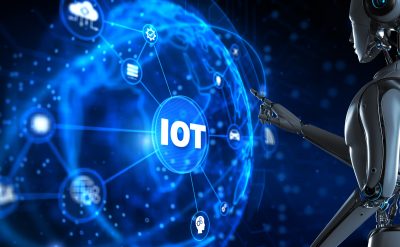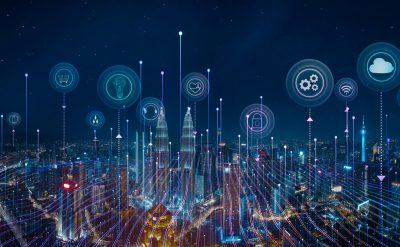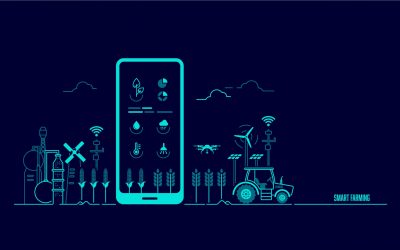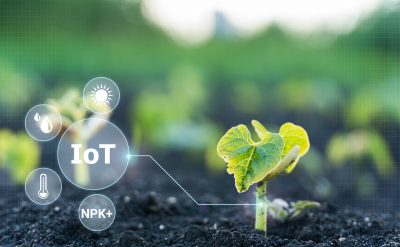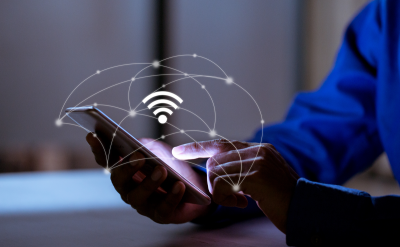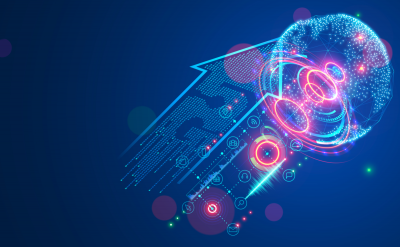The last decade has experienced a remarkable journey of digital transformation, and now the world is at a stage where almost everything is connected via the internet (even hearts – pun intended).
Today, the availability of constant connectivity works exactly like the concept of sci-fi movies where everything right from smart devices to appliances, buildings, and industries is connected with a robust combination of technology and the internet. So, your smartphone interacting with the refrigerator or the air conditioner is no more fiction, but reality fondly referred to as the Internet of Things (IoT).
What’s more interesting about this mainstream technology is the launch of 5G in 2020 that is predicted to make IoT more pervasive. Well, this undeniably makes the year 2020 an interesting one on the technology front.
And as per a study by IDC, the global spending on IoT is expected to reach at least $1 trillion by 2020.
Well, doesn’t that amount make your heart skip a beat? If yes, then without any further ado, it is time to discover more about what 2020 has in store for IoT, especially a list of things to be aware of and focus areas.
Revisiting the new age concept of IoT
Simply described, IoT is a vast network of smart objects that work collectively to gather and analyze data to perform actions. Not just this, but the progress in the genre of IoT has been remarkable over the past decade, and forecasts display accelerated growth in the coming years concerning both market value and the number of connected devices. Interesting, isn’t it? Also, the number of connected devices all over the world is estimated to reach about 50 billion in 2020 from 18 billion in the year 2015.
Well, this is absolutely intriguing, and I am sure this information is enough to bring IoT on the bucket list of businesses of every size, shape, and type.
Even though IoT is flourishing as a technology, there is still a certain amount of ambiguity about its future. Therefore, to make the most of this technology for your business, it is time to demystify the confusion and focus on trends that have the potential to determine the future of IoT, with the help of 7 valuable predictions that are hard to be ignored.
So, let’s get started
Trend #1
1. More IoT in healthcare
Yes, that’s true. Healthcare is transforming for better with the help of IoT. And in 2020, the healthcare industry will experience slow but steady growth with wider adoption of IoT devices.
As per a report by Frost and Sullivan, the concept of the internet of medical things is forecasted to increase at a CAGR of 26.2% and is expected to reach $72,000 million by 2021.
The technology will continue to improve exponentially, and not just this, but 2020 will be an innovative year for digital health as IoT will enable patient monitoring even outside healthcare facilities. Thanks to IoT that patients will also be able to access medical records remotely.
Another good thing about 2020, IoT, and healthcare is the proliferation of connection between IoT and portable devices, health monitors, sensors, and a wide range of other medical devices. Additionally, the popularity of intelligent wearables that enable communication with patients while traveling will experience a considerable rise.
2. More IoT in manufacturing
IoT in manufacturing or a fancy IIOT. Call it anything, but the growth graph of this technology looks promising in the year 2020. As garnering humongous amounts of data from a wide range of gadgets, machinery, and tools used in manufacturing is inevitable, and IoT continues to deliver steady development as more and more companies embark on the journey of digital transformation. So, to stay in the market and sustain or conquer the competition, it is time not to miss the bus to digital transformation.
PwC’s 2019 IoT Survey displays interesting figures as manufacturers are more confident about the technology, wherein 93% believe in its benefits as compared to risks. However, in the next 2 years, 68% manufacturers plan to make more investments in IoT.
Rob Mesirow, Leader of the PwC Connected Solutions/IoT Practice, states, “Manufacturers need to know that if they haven’t already implemented IoT, they’re already behind their competitors—81% of the industrial manufacturers have applied IoT to increase operational efficiency and almost two-thirds plan to increase their IoT investment over the next 2 years.” He added, “It’s also important to note the most popular IoT use cases, so manufacturers can better guide their own deployment plans. The main use cases are in logistics (50%), supply chain (47%), employee and customer experience (46%), and predictive maintenance (41%).”
Heads up
It is surprising to learn that despite the declining costs of IoT devices, about 44% of manufacturers still have not implemented IoT to prevent equipment from malfunctioning.
Whenever equipment on the shop floor experiences a breakdown, it can adversely impact entire operations as manufacturing largely depends on machinery.
Pros: Reduces cost, eliminates downtime, conserves energy, and adds to operational efficiency.
Additionally, businesses need to understand that sustainability and ethical practices are what makes a considerable difference to modern age consumers. Nowadays, more and more consumers are becoming conscious than before. So, now you will not just find people who care about the brand, but a lot more are concerned about ethics and make buying decisions based on the environmental impact of the product and resources used. By leveraging the power of IoT, manufacturers can focus on making their products future proof.
3. Consistent growth in home automation
Given the convenience and ease associated with home automation, IoT increasingly is becoming a part of our daily lives in some or the other way. In fact, the global market for smart home automation is expected to reach $40 billion by 2020. So how could we not mention it here in the most emerging prediction section?!
Furthermore, IoT devices are interconnected, and hence the technology makes it easier to manage multiple operations.
The smart home technology is expected to grow at a slow yet steady pace and will continue to make homes more interactive, where we will find devices telling humans what needs to be done and not the other way around. However, the only problem that companies need to deal with is security.
4. More self-driven cars
Driverless cars now are not a part of any futuristic technology. With IoT and other competitive technologies in place, companies like Tesla and BMW have already released driverless versions. So, the prevalence of driverless cars can be expected in the near future. As innovative giants such as Tesla, Google, and Uber are pushing the limits of innovation to take over in the genre of driverless cars.
As per a report, Business Insider predicts that about 10 million self-driven cars will be on the road by 2020.
Additionally, a large number of IoT experts forecast a huge number of cars to be connected via the internet by 2020. The inbuilt features and internet services will also play an active role in increasing the functionality of driverless vehicles. Google has already been testing these new-age driverless cars. Well, we do agree that the technology is still developing, but expect the same to be perfected in about 2 years.
Benefits: We will now not have to worry about parking slots, as driverless cars will drop you at your destination and move further. Isn’t that a relief. And not just this, but innovation and progress ahead have the potential to change the face of hospitality and safety. Another interesting perk associated with these driverless cars is that you will then not have to worry about drinking and driving. Now that’s interesting. Isn’t it?
5. Rise in the number of smart cities
Smart cities are a concept carried out at a vast scale in several countries, intending to improve the standard of living. And since the concept is not new, a lot of developing countries are exhibiting interest and coming up with smart city strategies.
Now it’s time to look at some real numbers. Below are highlights of some interesting, smart cities’ statistics for the year:
1. Smart city investments are scheduled to reach $158 billion by 2022.
2. By 2024, 45% of the city communities will implement IoT-enabled water management for usage, quality monitoring, and leak detection to combat water scarcity issues.
3. An astounding $34.5 billion is set as global spending for smart cities for 2020.
4. In North America alone, the IoT smart building market is expected to be $44.81 billion by 2020. Additionally, smart lighting in global residential buildings is projected to reach $2.88 billion.
5. The global smart city transportation genre is expected to see global automotive sensors market to invest finances worth $43 billion by the year 2021. Whereas, the shipment of connected cars is estimated to be 83.25 million units by 2020.
These numbers indeed look progressive and promising.
6. More need for data security
The year 2020, as it kicks into a brand new decade, demands more cybersecurity, and is expected to provoke newer business models with businesses providing their products as-a-service. Everything in an organization can be measured with devices, well that indirectly means there will be a lot of data generated again. Additionally, a lot of analytics and edge development can be experienced soon, as companies are striving to gain value with real-time data. This brings us to an era where IoT will generate large amounts of data. Hence, data security needs to be dealt with primarily.
However, ransomware attacks like Wannacry in May 2016, SamSam in late 2015, Ryuk in 2018 and 2019 and many more, should keep us on our toes, when it is the question of data security.
Since data leaks are increasing, a heavy focus on innovative and reliable methods of secure data sharing is a must. The World Economic Forum has also reported a shortage of people trained in cybersecurity. In fact, it is projected that there will be approximately 3.5 million unfilled jobs in cybersecurity by 2021 on a global scale.
As the IoT market is forecasted to grow exponentially in 2020, it is essential to understand that the rise in the popularity of connected devices also comes with concerns of security challenges. Therefore, in 2020, make sure to have an eagle’s eye on concerns such as insufficient testing and updating, brute force, and the issue of default passwords, IoT malware, and ransomware, IoT botnets aiming at cryptocurrency and data security and privacy concerns for mobile, web, and cloud platforms.
Pro tip: To keep cyber threats at a distance, use transport encryption and standards such as Transport Layer Security (TLS). Or you can also practice the use of different networks to isolate different devices.
Remember, precaution is always better than cure.
7. Unified integration framework
This might be surprising, but true. The biggest threat to IoT is not external but internal. We say this because the lack of coordination amongst industry giants to build a unified framework for IoT is lagging. It is hard to believe, but industry giants have spent time, resources, and energy to reinvent the wheel without creating a centralized and shared platform. Many of them have created very similar solutions but of no or very little value.
So, in 2020, the need for unified integration framework makes a lot of sense.
Conclusion
By far, these have been the most awaited and the most talked about predictions for IoT for the year 2020. If you want to explore this topic in detail or read whitepapers that have expertise and expert insights, download our latest whitepapers on IoT.



































































